 |
 |
 |
| |
2014 Affordable Care Act Enrollment of AIDS Drug Assistance Program Clients and Associated HIV Outcomes.....ACA Enrollment Improves Viral Load suppression by 45% [slides presented are included in this report]
|
| |
| |
Reported by Jules Levin, NATAP
IDSA 2015 Oct 7-11 San Diego, CA
Kathleen A. McManus, MD, MS1, Anne Rhodes, MS, PhD2, Steven Bailey, LCSW2, Lauren Yerkes, MPH2, Carolyn L. Engelhard MPA3, Karen S. Ingersoll PhD4, George J. Stukenborg PhD3, and Rebecca Dillingham, MD, MPH1
(1) Division of Infectious Diseases and International Health, University of Virginia, Charlottesville, VA, (2) Virginia Department of Health, Richmond, VA, (3) Department of Public Health Sciences, University of Virginia, Charlottesville, VA, (4) Department of Psychiatry and Neurobehavioral Sciences, University of Virginia, Charlottesville, VA
"Virginia ADAP has been instrumental in encouraging its clients to enroll in ACA insurance ......Virginia ADAP paid insurance premiums and medication copayments under the ACA's federal health insurance marketplace........RESULTS: ACA enrollees were more likely to have a good virologic outcome. -85.5% versus 78.7%.....ACA Enrollment (OR 1.451 (1.113-1.892), p=0.006) [almost 50% higher chance of undetectable viral load].....Each additional month of ACA insurance increases the rate of virologic suppression by 5.6%.
For one year of ACA insurance, the chance of virologic suppression increased 67.1%...... May be due to the addition of ACA insurance benefits to the strong infrastructure of federally funded Ryan White HIV clinics, where the most ADAP clients receive medical care........Promoting and assessing impacts of ACA enrollment in large cohorts of PLWH should be a priority to guide future policy decisionsrelated to HIV care delivery in the United States ......Less than half(n = 1853, 47.1%) of the eligible Virginia ADAP clients in Cohort A enrolled in ACA insurance plans......ACA enrollment varied greatly depending on HIV clinic(14-74%)."
------------------------
Public Release: 8-Oct-2015
Affordable Care Act helps Virginia improve HIV outcomes
While providing care for more for at-risk patients, study shows
Infectious Diseases Society of America
SAN DIEGO - Low-income HIV patients enrolled in Affordable Care Act (ACA) health care plans achieved better outcomes and the resulting cost savings allowed the state of Virginia to support care for more patients, according to a groundbreaking study from the University of Virginia being presented at IDWeek 2015™.
The study found that patients enrolled in ACA health care plans had higher rates of viral suppression - no or very little HIV virus detectable in the blood, the marker of successful HIV treatment - than those who received only medications for HIV through the state's direct AIDS Drug Assistance Program (ADAP). Researchers determined that ACA enrollment was affected by demographics such as age, race, gender and progression to an AIDS diagnosis, as well as systems-level factors, such as the 2013 ADAP coverage program they used, the federal tax credits they received and the specific HIV clinic where they received care.
"We found patients fared better under ACA health plans, possibly due to broader access to medical care and medications beyond those that target HIV," said Kathleen McManus, MD, MS, lead author of the study and a fellow physician in the Division of Infectious Diseases and International Health at the University of Virginia School of Medicine, Charlottesville. "Additionally, this approach allows the state to cover the largest number of patients in the most cost-effective way. ACA plans provide more comprehensive care for the same or less money."
Patients with HIV who are engaged in HIV care and take their anti-retroviral (ART) medications as prescribed are more likely to achieve viral suppression. Patients with viral suppression stay healthier, live longer, and are less likely to pass the virus on to others.
Using the ACA approach is particularly helpful because Virginia is one of 20 states that did not elect to expand Medicaid, meaning that many patients with low incomes remain ineligible for Medicaid and often fall through the cracks because they can't afford insurance and medications. Virginia provides care to these "Medicaid gap" HIV patients and to other low-income patients through the ADAP program. Since the passage of the ACA, there are two mechanisms through which ADAP can support care. Through direct ADAP, the state pays for patients' medications, and the patients typically receive treatment through Ryan White-funded clinics, which provide medical care and essential support services to people with HIV/AIDS who have insufficient health care coverage. The other option is for patients to sign up with an ACA health plan. Virginia ADAP then pays patients' premiums, deductibles and medication copays.
The two-year study included the 3,933 ACA-eligible ADAP patients in Virginia, comparing the outcomes of the 1,849 (47.1 percent) who enrolled in ACA plans to the 2,084 (52.9 percent) who continued to receive medications through direct ADAP. Viral suppression was achieved by 85.5 percent of those enrolled in the ACA, vs. 78.7 percent of those in the direct ADAP.
Because HIV medications are so expensive, researchers say providing ACA insurance is more cost-effective than paying for those medications directly. Therefore, more people living with HIV are covered. Prior to the availability of the ACA option, direct ADAP often had a waitlist due to limited resources. "Moving patients to ACA insurance helps the Virginia ADAP use federal and state funds to cover a larger number of patients and help avoid waitlists for medications and services," said Dr. McManus.
Every state has an ADAP, and while eligibility and coverage differ by state, all provide a safety net for people with HIV. One-third of people with HIV in the United States receive medications through a state ADAP.
"We believe enrolling patients in ACA health plans would help ADAP clients in states without Medicaid expansion and those in states with Medicaid expansion who still do not qualify for Medicaid, but are struggling to afford care," she said.
###
AT A GLANCE
· Low-income HIV patients are more likely to have good outcomes if they enroll in Affordable Care Act (ACA) health plans, a groundbreaking study suggests.
· The University of Virginia study suggests the patients are more likely to attain viral suppression (low levels of virus in the body), helping them stay healthier, live longer and decrease the chance of spreading the virus.
· Enrolling these patients in ACA plans provides a cost savings that enables Virginia to treat more patients.
· Other states may find the ACA approach helps them provide cost-effective and high-quality care to low-income patients with HIV, researchers note.
-----------------------------
THURSDAY, Oct. 8, 2015 (HealthDay News) -- Low-income HIV patients who enrolled in Obamacare may be faring better than they did on traditional state assistance, a new study suggests.
At least that's the case in Virginia, where the study was done. Researchers found that people infected with HIV (the virus that causes AIDS) who switched from the state's drug-assistance program to an Obamacare insurance plan had greater odds of gaining better control of the disease.
Those who enrolled in a plan in 2014 were more likely to get their HIV "viral load" down to very low or undetectable levels in the blood, the study found.
"That's the most exciting finding from this study," said lead researcher Dr. Kathleen McManus, a fellow at the University of Virginia School of Medicine, in Charlottesville, Va.
"When patients achieve viral load suppression, they're healthier and they're less likely to pass the virus on to other people," said McManus.
McManus is scheduled to present the study results Friday at Infectious Diseases Week, a meeting of infectious disease specialists in San Diego. Findings presented at meetings are generally viewed as preliminary until they've been published in a peer-reviewed journal.
Virginia, like all other U.S. states, has an AIDS Drug Assistance Program (ADAP). The programs help low-income HIV patients who are either uninsured or "underinsured" afford the expensive drugs used to control the disease, the study authors said.
Traditionally, ADAP has paid for the medications, and patients generally received their medical care at federally funded clinics, according to the researchers.
But the Affordable Care Act (ACA) -- also known as Obamacare -- opened another option, McManus explained. ADAP programs can now sign patients up with an insurance plan, then pay for their premiums, deductibles and medication co-pays.
"There've been some concerns about how this large national policy change could affect patients," McManus said.
This study offers reassurance, she said, and suggests that HIV patients could actually fare better on Obamacare.
And why would that be? It's possible, McManus said, that people who shifted to an ACA health plan gained better access to medical care in general.
Dr. Carlos del Rio, a spokesman for the Infectious Diseases Society of America, agreed. "They may have received better care for other chronic disease, like diabetes, that commonly affect people with HIV," said del Rio, who was not involved in the study.
Better overall health and well-being could, in turn, help people gain more control over their HIV.
Del Rio called the results "exciting," but added that important questions remain: Is this happening in other states? And what will the longer-term effects -- on both people's health and health care spending -- ultimately be?
"We need to look beyond the effects on viral load," del Rio said.
It's clear that "healthier patients are less expensive patients," he noted. But the financial impact of moving ADAP patients to Obamacare health plans remains to be seen, del Rio said.
According to McManus, shifting HIV patients to Obamacare does open up resources to cover a larger number of patients. The traditional ADAP program often had wait-lists for medications and services, she said.
Moving patients to health plans could also be cost-effective for states, McManus and her colleagues suggested, because HIV drugs are so expensive.
The findings are based on a two-year study of nearly 4,000 Virginia ADAP patients who were eligible to move to an Obamacare health plan in 2014.
Overall, 47 percent made the switch, the study found. And, patients who made the switch increased their odds of achieving HIV viral suppression by 45 percent compared to patients who stayed with ADAP, the research revealed.
"Given what we found, it's unfortunate that less than half of those patients enrolled in an ACA plan," McManus said. One of the next steps, she added, will be to figure out what keeps people from enrolling.
This study offered some clues: Patients' likelihood of enrolling varied according to the HIV clinic where they received care, and the federal tax credit they stood to gain, for example.
Lack of awareness, worries about medication co-pays, or even difficulty getting Internet access could all be factors, McManus said.
Virginia is not the only state moving ADAP patients into Obamacare plans, and McManus said her team's findings raise the hope that the policy shift is having widespread positive effects.
She noted that Virginia is one of 20 states that chose not to expand Medicaid under the new health care law. Helping ADAP patients get into an Obamacare plan could be especially important in those states, she said.
------------------
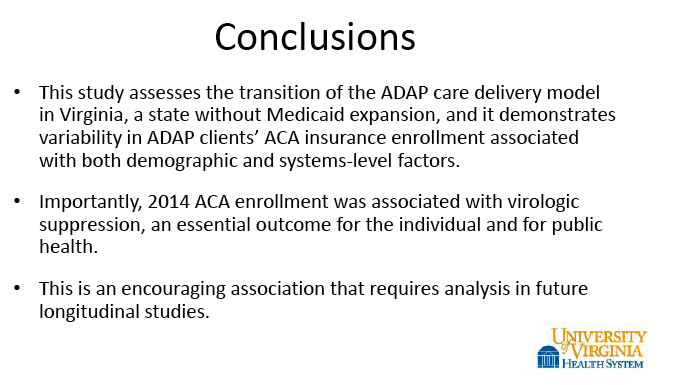
Program abstract
Background: Before the Affordable Care Act (ACA), state AIDS Drug Assistance Programs (ADAPs) were the safety net providing antiretroviral therapy to uninsured/underinsured people living with HIV (PLWH). Many ADAPs, including Virginia, shifted their healthcare delivery model from a focus on direct medication provision to the purchase of insurance with the advent of ACA in 2014. Virginia ADAP helped enroll clients in ACA insurance plans and paid monthly premiums, medication copayments and deductibles. The objective of this study is to characterize the demographic and systems-level factors in Virginia ADAP clients' ACA enrollment and to assess the relationship between ACA enrollment and HIV viral load (VL) suppression.
Methods: The cohort includes people with a diagnosis of HIV who were at least 18 years old, enrolled in ADAP before July 1, 2013, and eligible for ACA insurance. The Virginia Department of Health (VDH) provided a database with data collected from January 1, 2013 through December 31, 2014.
Results: Of Virginia's 3933 ACA-eligible ADAP clients, 47.1% enrolled in ACA insurance plans. In multivariable binary logistic regression analysis assessing factors associated with ACA enrollment, age, race/ethnicity, sex, Income/Financial Incentives, HIV/AIDS Diagnosis, 2013 ADAP Plan, and HIV Clinic were statistically significant. In multivariable binary logistic regression analysis, statistically significant factors associated with achieving HIV VL suppression include ACA enrollment (OR 1.45, p=0.006), starting with an undetectable HIV VL in 2013, more time between VLs, HIV/AIDS diagnosis, and HIV clinic.
Conclusion: This unique and timely project creates a statewide picture of the transition of the ADAP care delivery model in Virginia, a state without Medicaid expansion. This analysis demonstrates that across demographic and systems-level factors, there was variability in ADAP clients' ACA insurance enrollment. Importantly, ACA enrollment in 2014 was associated with HIV VL suppression, an essential outcome for the individual and for public health. This association should continue to be tracked over time, as more PLWH enroll in insurance programs and remain on insurance for longer periods of time.
------------------------

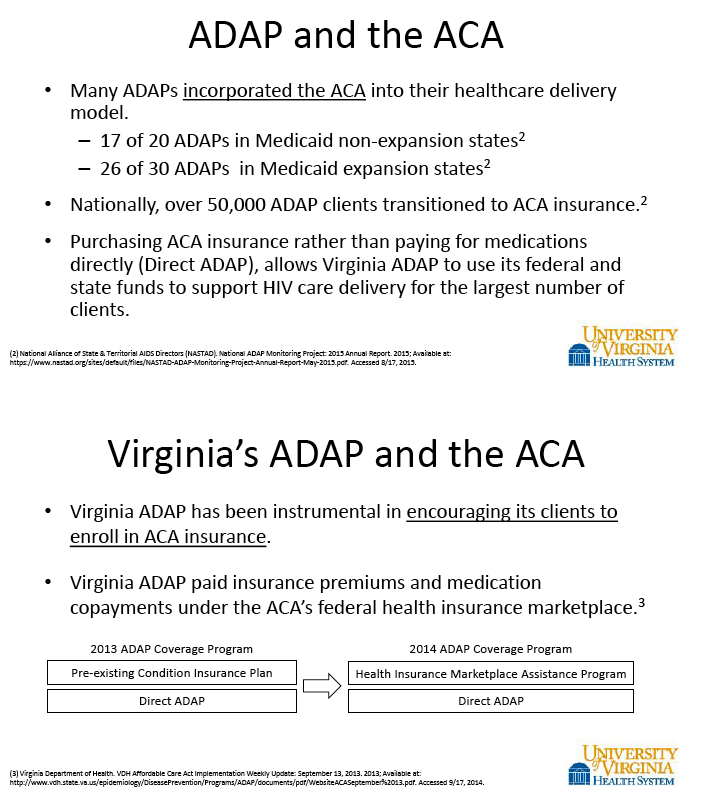
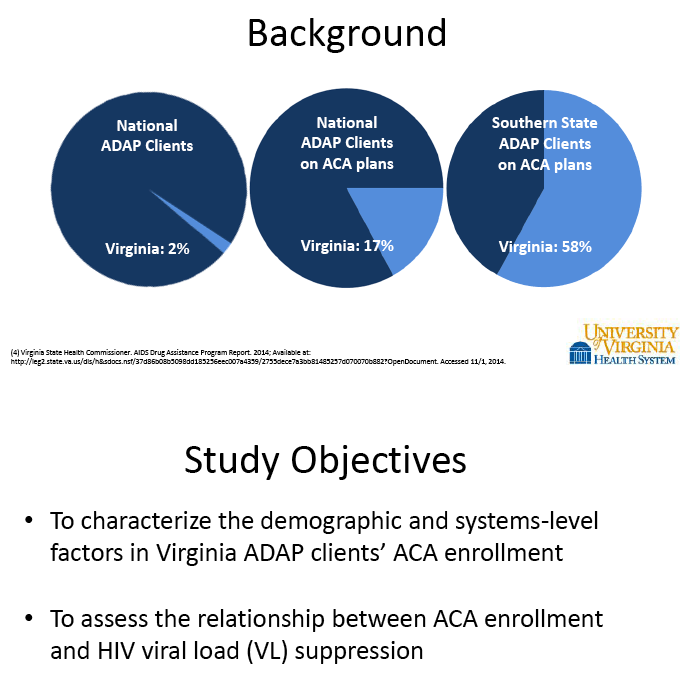
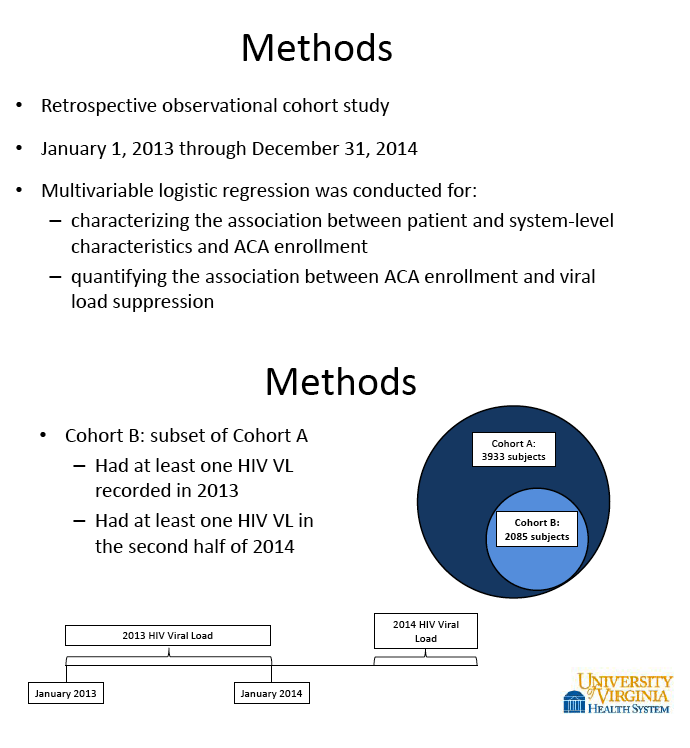

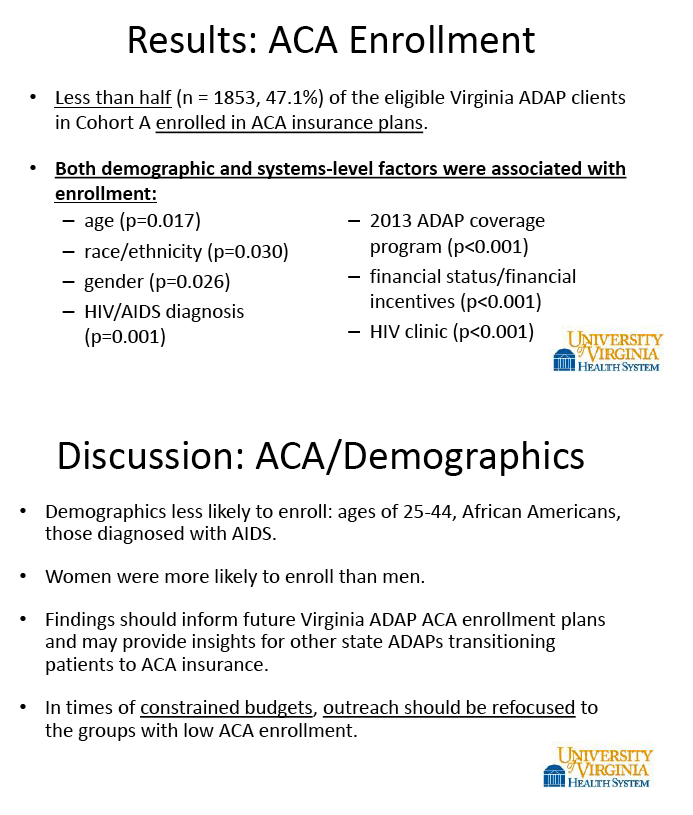
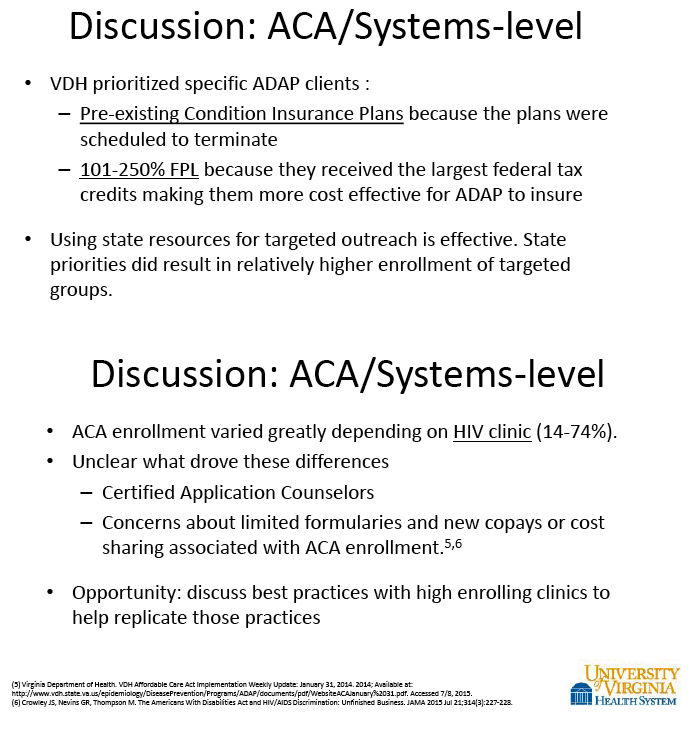
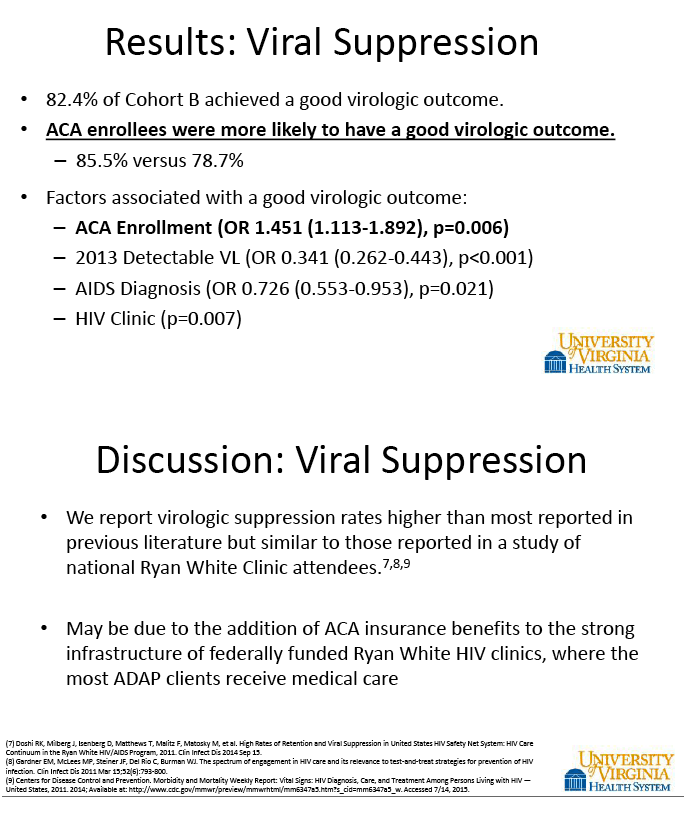
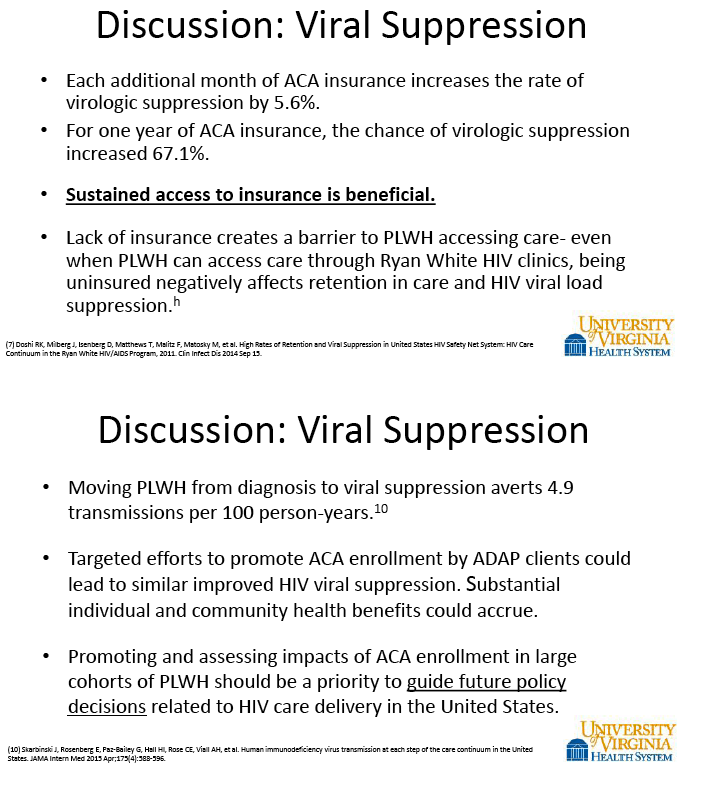
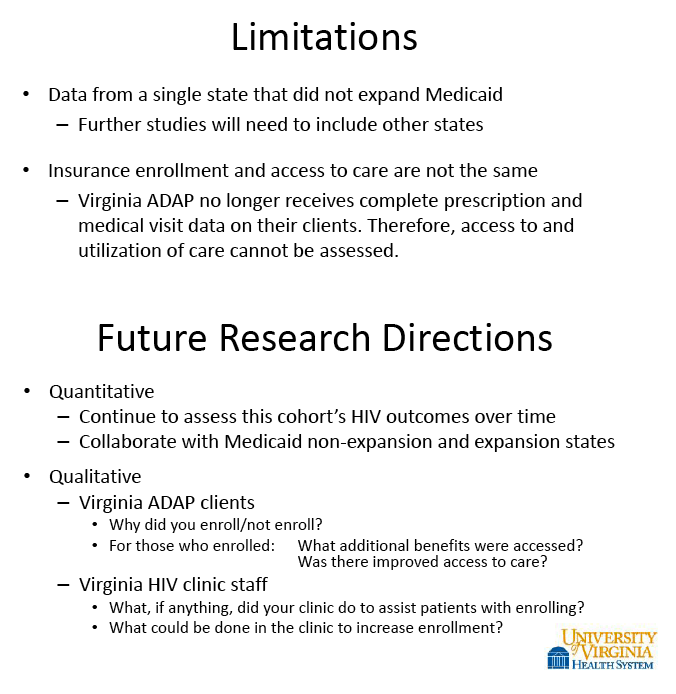
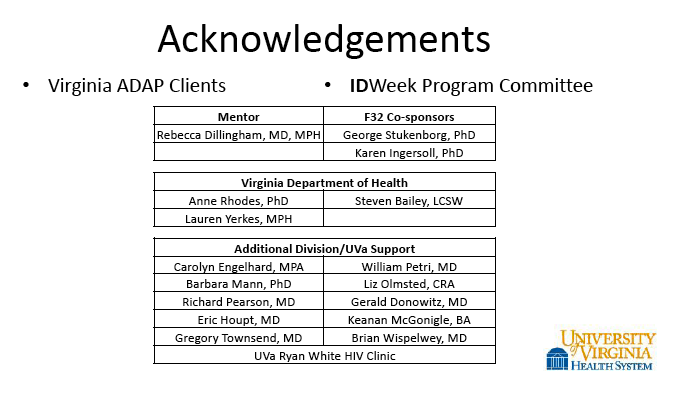
|
| |
|
 |
 |
|
|